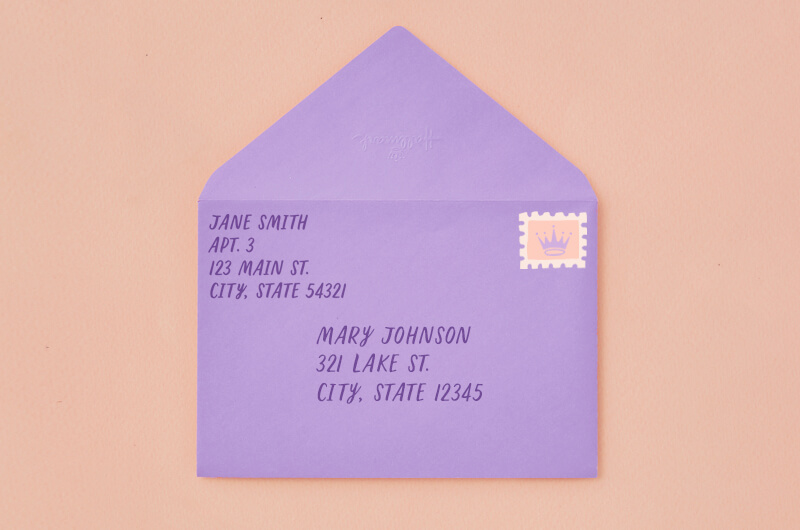The Art of Addressing: A Comprehensive Guide to Envelope Etiquette
The humble envelope, often overlooked, plays a vital role in the art of communication. Addressing an envelope correctly ensures your message reaches its intended recipient efficiently. This comprehensive guide delves into the proper etiquette and practical steps for addressing envelopes, empowering you to navigate the postal world with confidence.
Unveiling the Anatomy of an Envelope
Before diving into the specifics of addressing, let’s familiarize ourselves with the key components of an envelope:
- Front ( лицевая сторона [litsaevaya storona] – Russian): This is the flat side where you write the recipient’s address and postage.
- Back ( оборотная сторона [oborotnaya storona] – Russian): This is the opposite side of the front, often used for the return address (optional for some mail types).
- Flap ( клапан [klapan] – Russian): This is the closure section of the envelope that folds over to seal the contents.
- Return Address: This is your address, typically placed in the top left corner of the back of the envelope.
- Recipient Address: This is the address of the person you are sending the mail to, prominently displayed on the front of the envelope.
The Essential Elements of a Recipient Address
A well-formatted recipient address consists of several key elements:
- Recipient Name: Write the full name of the recipient, including titles (Mr., Ms., Dr., etc.) if applicable.
- Apartment or Unit Number (if applicable): For deliveries to multi-unit buildings, include the apartment or unit number after the recipient’s name on a separate line.
- Street Address: Write the street address, including the house number and street name.
- City, State, and ZIP Code: On the next line, include the city, followed by a comma, then the state abbreviation (US) or province/territory code (Canada), and finally, the ZIP code (US) or postal code (Canada).
Here’s an example of a well-formatted recipient address:
Ms. Jane Doe
Apt. 2B
123 Main Street
Anytown, CA 12345
Additional Considerations for Addressing Envelopes
- Courtesy Titles: For formal correspondence, consider using courtesy titles like Mr., Ms., Dr., etc., before the recipient’s name.
- Organization Mail: When addressing an organization, write the full name of the organization on the first line, followed by the department or specific person’s name (if known) on the second line.
- International Mail: For international mail, consult the specific formatting requirements of the destination country’s postal service. You might need to include the country name in a prominent location.
Addressing with Flair: Tips and Tricks
While proper formatting is essential, here are some additional tips for a polished look:
- Clarity is Key: Use clear and legible handwriting or printed text.
- Center Alignment: Center the recipient address both horizontally and vertically on the front of the envelope.
- Pen Choice: Opt for a dark pen color like blue or black for optimal readability by postal sorting machines.
- Return Address: While not always mandatory, including your return address on the back of the envelope ensures your mail gets back to you if undeliverable.
Frequently Asked Questions (FAQ)
Q: Where do I put the stamp on an envelope?
A: Place the postage stamp in the upper right corner of the front of the envelope.
Q: Can I abbreviate words on the envelope?
A: It’s generally discouraged to abbreviate words on the envelope except for standard abbreviations like St. (Street) or Ave. (Avenue). Clarity is paramount for efficient mail delivery.
Q: What if I make a mistake on the recipient address?
A: If you catch a mistake before mailing, simply cross out the error neatly and rewrite it correctly. For already mailed envelopes with minor errors, they might still reach the recipient if the core information (name and general location) is accurate. However, significant errors could lead to delays or undelivered mail.
Q: Do I need to include a return address for domestic mail?
A: Including a return address is not mandatory for domestic mail within the US, but it’s highly recommended. It ensures your mail gets back to you if there’s a delivery issue.
Addressing Specific Mail Types
- Large Envelopes and Packages: For larger mail items that don’t fit standard envelopes, the recipient address is typically placed in the center of the largest flat surface. Ensure the address is clear and free of obstructions from postage or other markings.
- Greetings Cards: For greeting cards, the recipient’s name is usually written in the center of the front of the card. You can optionally include your name on the back of the card, near the bottom flap.
- Bulk Mailings: If you’re sending out a large number of envelopes, consider using mailing software or online services that can generate and print address labels directly onto the envelopes.
International Mail Nuances
Addressing international mail requires additional considerations:
- Country-Specific Formats: Research the specific formatting requirements for the destination country. Postal codes, abbreviations, and even the order of address elements might differ from what’s used domestically.
- Global Address Format (GAF): The Global Address Format (GAF) is a standardized way of writing addresses for international mail. While not universally adopted, it can serve as a helpful reference point.
- Customs Forms: For packages containing goods, you might need to complete a customs form that declares the contents and their value. Consult your local postal service for guidance.
By familiarizing yourself with these additional considerations, you can ensure your international mail reaches its destination smoothly.
Conclusion
The humble envelope, often overlooked, plays a vital role in the art of communication. Addressing an envelope correctly ensures your message reaches its intended recipient efficiently. This comprehensive guide delved into the proper etiquette and practical steps for addressing envelopes, empowering you to navigate the postal world with confidence. We explored the anatomy of an envelope, identified the essential elements of a recipient address, and offered tips for a polished and professional look.
Furthermore, we discussed addressing specific mail types like large envelopes and greeting cards, along with the nuances of international mail, including country-specific formats and customs forms.
By understanding these concepts and incorporating these valuable tips, you’ll be well on your way to addressing envelopes like a pro. Remember, a well-addressed envelope not only ensures your message reaches its intended recipient but also creates a positive first impression. So, the next time you have a letter to send, take a moment to address it with care and let the art of communication begin!



